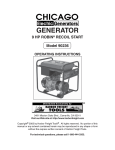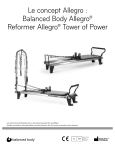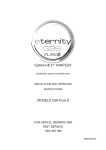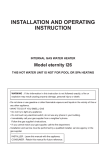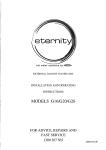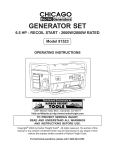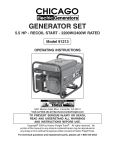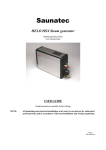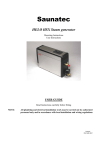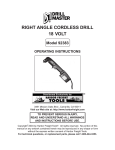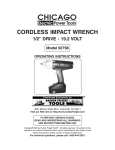Download Contractor GEN8000 Instruction manual
Transcript
8000W GENERATOR Stock No. GEN8000/03213 Instruction Manual PRODUCT SPECIFICATIONS Item VAC E lectrical R equirem ents VDC E lectrical R equirem ents V oltm eter E quipped D isplay Lights G asoline E ngine Fuel Tank C apacity E stim ated R un Tim e A pprox. W eight Generator Type Description 120 Volts 60Hz @ 47 AMPs Current Output 240 Volts 60Hz @ 23 AMPs Current Output Continuous/Rated Wattage: 6,000 Peak Wattage: 8,000 Two 120V Outlet, One 240 Twist Lock Outlet One 47 AMP circuit breaker, One 23 AMP circuit breaker C urrent O utput: 12 V D C @ 10 A M P 's 0-150 V olts (50 V olt Increm ents) R ed (R un) 13 HP / Unleaded Gasoline Powered Recoil Start / 4-Cycle OHV Air cooled 389 CC Displacement / 3600 RPM 1.05 Quart (1.0 Liter) Oil Capacity EPA Approved 5.60 G allons (25 Liters) / Includes Fuel G auge 9.0 C ontinuous O perating Hours 181 P ounds Brushless / Revolving Field / Self Exciting Two Pole / Single Phase CAUTION: THIS GENERATOR IS NOT INTENDED TO POWER SENSITIVE ELECTRONIC EQUIPMENT (INCLUDING MEDICAL EQUIPMENT) WITHOUT THE ADDITION OF AN APPROPRIATE LINE CONDITIONER (SOLD SEPARATELY). This product requires oil and fuel to be added before starting. Attempting to start the engine without oil WILL ruin the engine and void the warranty. BEFORE starting the engine, refer to the engine owner’s manual for engine maintenance information. SAVE THIS MANUAL You will need this manual for the safety warnings and precautions, operating, inspection, maintenance and cleaning procedures, parts list and assembly diagram. Keep your invoice with this manual. Write the invoice number on the inside of the front cover. Keep this manual and invoice in a safe and dry place for future reference. PAGE 2 GENERAL SAFETY RULES WARNING! READ AND UNDERSTAND ALL INSTRUCTIONS Failure to follow all instructions listed below may result in electric shock, fire, and/or serious injury. SAVE THESE INSTRUCTIONS WORK AREA 1. Keep your work area clean and well lit. Cluttered benches and dark areas invite accidents. 2. Do not operate power tools in explosive atmospheres, such as in the presence of flammable liquids, gases, or dust. Generators create sparks which may ignite the dust or fumes. 3. Keep bystanders, children, and visitors away while operating a generator. Provide barriers or shields as needed. ELECTRICAL SAFETY 4. Grounded tools must be plugged into an outlet properly installed and grounded in accordance with all codes and ordinances. Never remove the grounding prong or modify the plug in any way. Do not use any adapter plugs. If the tools should electrically malfunction or break down, grounding provides a low resistance path to carry electricity away from the user. 5. Double insulated tools are equipped with a polarized plug (one blade is wider than the other). This plug will fit in a polarized outlet only one way. If the plug does not fit fully in the outlet, reverse the plug. If it still does not fit, contact a qualified electrician to install a polarized outlet. Do not change the plug in any way. Double insulation eliminates the need for the three wire grounded power cord and grounded power supply system. 6. Avoid body contact with grounded surfaces such as pipes, radiators, ranges, and refrigerators. There is an increased risk of electric shock if your body is grounded. PAGE 3 7. Do not expose Generator to rain or wet conditions. Water entering a generator will increase the risk of electric shock. 8. Do not abuse the Power Cord. Keep Power Cords away from heat, oil, sharp edges, or moving parts. Replace damaged Power Cords immediately. Damaged Power Cords increase the risk of electric shock. 9. When operating a power tool outside, use an outdoor extension cord marked “W-A” or “W”. These extension cords are rated for outdoor use, and reduce the risk of electric shock. PERSONAL SAFETY 10. Stay alert. Watch what you are doing, and use common sense when operating a generator. Do not use a generator while tired or under the influence of drugs, alcohol, or medication. A moment of inattention while operating generators may result in serious personal injury. 11. Dress properly. Do not wear loose clothing or jewelry. Contain long hair. Keep your hair, clothing, and gloves away from moving parts. Loose clothes, jewelry, or long hair can be caught in moving parts. 12. Avoid accidental starting. Make sure the Power Switch is in its “OFF” position, and disconnect the Spark Plug Wire when not in use. 13. Remove adjusting keys or wrenches before turning the generator on. A wrench or a key that is left attached to a rotating part of the generator may result in personal injury. 14. Do not overreach. Keep proper footing and balance at all times. 15. Use safety equipment. Always wear eye protection. Wear safety impact eye goggles. Dust mask, non-skid safety shoes, hard hat, or hearing protection must be used for appropriate conditions. 16. Do not force the generator. Use the Correct generator for your application. The correct generator will do the job better and safer at the rate for which it is designed. 17. Do not use the generator if the Power Switch does not turn it on or off. Any generator that cannot be controlled with the Power Switch is dangerous and must be replaced. PAGE 4 GENERATOR USE AND CARE 18. Make sure the Power Switch is in its “OFF” position and disconnect the spark plug wire before making any adjustments, changing accessories, or storing the generator. Such preventive safety measures reduce the risk of starting the generator accidentally. 19. Store idle generators out of reach of children and other untrained persons. Generators are dangerous in the hands of untrained users. 20. Maintain generators with care. Do not use a damaged generator. Tag damaged generators "Do not use" until repaired. 21. Check for misalignment or binding of moving parts, breakage of parts, and any other condition that may affect the generator’s operation. If damaged, have the generator serviced before using. Many accidents are caused by poorly maintained generators. 22. Use only accessories that are recommended by the manufacturer for your model. Accessories that may be suitable for one generator may become hazardous when used on another generator. PAGE 5 SPECIFIC PRODUCT WARNINGS AND PRECAUTIONS INSTALLATION PRECAUTIONS 1. Warning: Never connect this generator to your house or any other structures wiring. This unit is not designed to be used as a standby generator to be wired to your electrical panel. It is designed to be used to provide power to either 120V or 240V electrical devices by plugging the device into the generator. Failure to follow these instructions could lead to damage to appliances and the structures wiring that it is connected to. 2. The earth ground connection should be completed by a licensed electrician. 3. Any separate fuel storage or Generator supply facility must be built or installed in full compliance with all relevant local, state, and federal regulations. 4. It is recommended to use the Generator only in well ventilated outdoor areas. A running gasoline engine will generate Carbon Monoxide, a colorless, odorless gas that, if inhaled, can cause serious injury or death. Generator exhaust fumes must be within legal limits and installation must always meet local building codes. 5. If the generator is installed outdoors, it must be weatherproofed and should be soundproofed. It should not be run outdoors without protection to the Generator and wiring conduit. 6. Two or more people should assist when moving or lifting this product. Never lift the Generator using the engine or alternator lifting lugs. Connect lifting equipment to the Frame of the Generator. 7. Before lifting the Generator, ensure the lift rigging and supporting structure are in good condition, and are rated to lift such a load. 8. Keep all personnel away from the suspended generator during relocating. PAGE 6 9. The supporting floor/ground surface should be level, and strong enough to safely hold the weight of the Generator. If the floor/ground surface is not level, strong cross members should be placed under the full length of the Generator Frame at its low side. 10. For trailer installation, the Generator should be mounted on the center point of the trailer, over the wheels. The trailer must be capable of supporting the weight of the Generator and all contents (tools, etc.) 11. Install sound- and weather-proofing only when it is not raining or snowing to avoid trapping moisture within the Generator's area. FIRE AND EXPLOSION PRECAUTIONS 1. Gasoline fuel and fumes are flammable, and potentially explosive. Use proper fuel storage and handling procedures. Always have multiple ABC class fire extinguishers nearby. 2. Keep the Generator and surrounding area clean at all times. 3. When spills of fuel or oil occur, they must be cleaned up immediately. Dispose of fluids and cleaning materials as per any local, state, or federal codes and regulations. Store oil rags in a covered metal container. 4. Never store fuel or other flammable materials near the Generator. 5. Do not smoke, or allow sparks, flames or other sources of ignition around the Engine and Fuel Tank. Fuel vapors are explosive. 6. Keep grounded conductive objects, such as tools, away from exposed, live electrical parts and connections to avoid sparking or arcing. These events could ignite fumes or vapors. 7. Do not refill the Fuel Tank while the Engine is running or while the Engine is still hot. Do not operate the Generator with known leaks in the fuel system. 8. Excessive buildup of unburned fuel gases in the exhaust system can create a potentially explosive condition. This buildup can occur after repeated failed start attempts, valve testing, or hot engine shutdown. If this occurs, open exhaust system drain plugs, if equipped, and allow the gases to dissipate before attempting to restart the Generator. PAGE 7 MECHANICAL PRECAUTIONS 1. ALWAYS make sure the Power Switch is in its "OFF" position. Disconnect the spark plug wire, and allow the Engine to completely cool before carrying out maintenance. 2. Check for damaged parts. Before using the Generator, any part that appears damaged should be carefully checked to determine that it will operate properly and perform its intended function. Check for alignment and binding of moving parts, any broken parts or mounting fixtures, and any other condition that may affect proper operation. Any part that is damaged should be properly repaired or replaced by a qualified technician. 3. The Generator is designed with guards for protection from moving parts. In any case, care must still be taken to protect personnel and equipment from other mechanical hazards when working around the generator. 4. Do not operate the Generator with safety guards removed. While the Generator is running, do not attempt to reach around the safety guards for maintenance or any other reason. 5. Keep hands, arms, long hair, loose clothing, and jewelry away from moving parts. Be aware that when engine parts are moving fast they cannot be seen clearly. 6. Keep access doors on enclosures closed and locked when access is not required. 7. When working on or around the Generator always wear protective clothing including ANSI approved safety gloves, safety eye goggles, and safety hat. 8. Do not alter or adjust any part of the Generator that is assembled and supplied by the manufacturer. 9. Always follow and complete scheduled Engine and Generator maintenance. CHEMICAL PRECAUTIONS 1. Avoid contact with hot fuel, oil, exhaust fumes, and hot solid surfaces. 2. Avoid body contact with fuels, oils, and lubricants used in the Generator. If swallowed, seek medical treatment immediately. Do not induce vomiting if fuel is swallowed. For skin contact, immediately wash with soap and water. For eye contact, immediately flush eyes with clean water and seek medical attention. PAGE 8 ELECTRICAL PRECAUTIONS 1. All connections and conduits from the Generator to the load must only be installed by trained and licensed electricians, and in compliance with all relevant local, state, and federal electrical codes and standards, and other regulations where applicable. 2. The Generator must be earth-grounded for fixed installations in accordance with all relevant electrical codes and standards before operation. WARNING! The 120v outlet is protected with a 47 amp breaker. You must provide adequate protection for the size of cord and equipment you are using by means of a power strip equipped with a circuit breaker. 3. R If an extension cord (not included) is used, make sure to use only UL approved cords having the correct gauge and length. (See Figure A.) REQUIRED MINIMUM EXTENSION CORD GAUGE – 120 VOLT NAMEPLATE AMPERES (At Full Load) 0-5 5.1 - 8 8.1 - 12 12.1 - 15 15.1 - 20 20 - 47 EXTENSION CORD LENGTH 0 - 25 Feet 16 16 14 12 10 6 25 - 50 Feet 16 16 14 12 10 - 50 -100 Feet 16 14 12 10 10 - 100 – 150 Feet 12 10 - 150– 200 Feet 12 - FIGURE A 4. Do not attempt to connect or disconnect load connections while standing in water, or on wet or soggy ground. 5. Do not touch electrically energized parts of the Generator and interconnecting cables or conductors with any part of the body, or with any non-insulated conductive object. 6. Connect the generator only to a load or electrical system (110/120 volt) that is compatible with the electrical characteristics and rated capacities of the Generator. 7. Before servicing equipment powered by the Generator, disconnect the equipment from its power input. PAGE 9 8. Keep all electrical equipment clean and dry. Replace any wiring where the insulation is cracked, cut, abraded or otherwise degraded. Replace terminals that are worn, discolored, or corroded. Keep terminals clean and tight. 9. Insulate all connections and disconnected wires. 10. Guard against electric shock. Prevent body contact with grounded surfaces such as pipes, radiators, ranges, and refrigerator enclosures. INSTALLATION 1. NOTE: Prior to powering tools and equipment, make sure the Generator's rated voltage, wattage, and amperage capacity (120V - 47AMPs) is adequate to supply all electrical loads that the unit will power. If powering exceeds the Generator's capacity, it may be necessary to group one or more of the tools and/or equipment for connection to a separate Generator. 2. WARNING! The Generator weighs approximately 181 pounds. Use care and the proper lifting or hoisting equipment when moving it to the installation location. Always connect hoist lines to the Frame (41) of the Generator. GENERAL LOCATION 1. It is recommended to locate and install the Generator outdoors where cooling air is readily available. 2. Install the Generator so that the air inlets and outlets are not blocked by obstructions such as bushes, trees, or snow drifts. Locating it in the path of heavy winds or snowdrifts may require the placement of a barrier for protection. The air inlet, in normal weather conditions, should face the prevailing wind direction. 3. Install the Generator on a concrete slab or other area where rain drainage or flood waters can not reach it. 4. Generator placement should allow four feet of access to all sides for maintenance. PAGE 10 5. Place the Generator as close as possible to the electrical tools and equipment being powered to reduce the length of extension cords. GENERATOR SUPPORT AND MOUNTING 1. Mount the Generator on a concrete slab capable of supporting the weight of the Generator. The slab must extend on all sides beyond the Frame (41) by at least one foot. Contact a cement contractor for slab specifications if necessary. Attach the Frame to the concrete slab using 3/8" diameter expansion anchor bolts (not supplied). OPERATING INSTRUCTIONS NOTE: For additional references to the parts listed in the following pages, refer to the Assembly Diagrams on pages 19 and 21. Pre-Start Checks: 1. Check to make sure the Engine Power Switch (2) is in its “OFF” position. (See Figure B, next page.) 2. IMPORTANT! Prior to first using the Generator, the Engine MUST be filled with approximately 3/4 (0.63) quart of a high quality SAE 10W-30 grade engine oil. To do so, unscrew and remove the Engine's Oil Dipstick (65A) located at the bottom of the Engine Crankcase. Fill the Engine's Crankcase until the oil level is level with the upper marked line on the Dipstick. Then, screw the Dipstick back into the Oil Fill Hole. (See Figure C, next page.) PAGE 11 POWER SWITCH (2) GROUND CONNECTOR (8) #6AWG GROUNDING WIRE (NOT INCLUDED) GROUNDING ROD (NOT INCLUDED) (33) FUEL TANK (30) PAGE 12 3. Before the first use, remove the Fuel Tank Cap (33) and fill the Fuel Tank (30) with unleaded gasoline. Then, replace the Fuel Tank Cap. Thereafter, check the Engine's Fuel Gauge (34) for the amount of unleaded gasoline in the Fuel Tank. If necessary, refill the Fuel Tank with unleaded gasoline; the Generator must be turned off and cooled down before refilling the fuel tank. (See Figure C.) To Start The Engine: 1. Make sure the electrical powered tools/equipment that will be used are not plugged into the Generator while the Engine is started. 2. Turn the 120 volt circuit breaker (5) to its "OFF" position. (See Figure D.) 3. 4. Open the Fuel Valve (40). (See Figure E.) Close the Choke Lever (21A) to about 1/8" clearance. (See Figure E.) PAGE 13 5. Turn the Engine Power Switch (2) to its "ON" position. (See Figure F.) 6. Hold the Start Handle (41A) loosely and pull it slowly several times to allow the gasoline to flow into the Engine's carburetor. Then hold the Start Handle firmly and pull the rope hard and fast. Pull the rope all the way out, using two hands if (32)times until the Engine starts. necessary. If necessary pull theFUEL rope TANK several (See Figure G.) 7. Allow the Engine to run for several seconds. Then, open the Choke Lever (21A) all the way. (See Figure E.) PAGE 14 Prior to powering tools and equipment, make sure the Generator's rated voltage, and amperage capacity (120V 47AMP, 240V 23AMP) is adequate to supply all electrical loads that the unit will power. If powering exceeds the Generator's capacity, it may be necessary to group one or more of the tools and/or equipment for connection to a separate generator. Once the generator is running select the desired voltage with the voltage selector switch located below the voltmeter, then simply connect the power cords to the correct outlet and turn on both breakers. Warning, turning on only one of the breakers will cause the unit to only put out 1/2 of the total output. (See Figure G.) 3. NOTE: The Generator features AC Non Fuse circuit breakers (5) to protect the AC circuit in case of an overload occur the Breaker will "trip" to its "OFF" position. In this case, refer to Step #1 above in this section. Then, reset the circuitry system by turning the circuit Breaker to its "ON" position. Restart the Generator and continue powering the remaining tools and equipment. (See Figure D.) When finished using the generator, shut the circuit breakers off and then turn the engine power switch to its "OFF" position. Turn the Fuel valve to its "OFF" position. Then, disconnect all electrical powered tools and equipment from the Generator's 120 volt AC Duel Outlets (6). (See Figures E, F, and G.) PAGE 15 3. If using only a 12 volt DC tool or equipment turn both the 120v and 240v breakers to their "OFF" position.(See Figure D.) 4. Start and run the Engine as previously discussed in this manual. 5. When finished using the Generator, turn the Engine Power Switch (2) to its “OFF” position. Turn the Fuel Valve (40) to its “OFF” position. Then, disconnect the electrical powered tools' power cord from the Generator's DC Terminals (7). (See Figure H.) 6. After the Engine and Generator have completely cooled, store the Generator in a safe, clean, dry location (if not already installed in one). 7. NOTE: The Generator features a 10 AMP DC Fuse (9) to protect the DC circuit in case of an overload. Should an overload occur the Fuse will burn out. In this case, refer to Step #1 in this section. Then, reset the circuitry system by replacing the burnt Fuse with a new 10 AMP DC Fuse. Restart the Generator and continue powering the remaining tool or equipment. (See Figure H.) PAGE 16 INSPECTION, CLEANING, AND MAINTENANCE 1. CAUTION! Always make sure the Engine Power Switch (2) is in its “OFF” position. Disconnect the spark plug wire from the engine. And allow sufficient time for the Engine and Generator to completely cool before performing any inspection, maintenance, or cleaning. 2. Before each use, inspect the general condition of the Generator. Check for loose screws, misalignment or binding of moving parts, cracked or broken parts, damaged electrical wiring, and any other condition that may affect its safe operation. If an Engine problem occurs, always have the Engine immediately checked out by a qualified service technician before further use. Do not use damaged equipment. 3. Before each use, check to make sure the Engine's oil level and gas level is adequate. If necessary, fill the Engine's Crankcase until the oil level is even with the Oil Fill Hole, and fill the fuel tank. 4. Before each use, With a soft brush, cloth, or vacuum, remove all debris from the Generator. Then, use a premium quality, lightweight machine oil to lubricate all moving parts. 5. Every 20 hours of use, drain the old Engine oil and replace with approximately 3/4 (0.63) quart of a high quality SAE 10W-30 grade engine oil. 6. Every 300 hours of use, have a qualified, certified technician perform thorough maintenance on the Generator and its Engine. 7. For long term storage, either drain fuel into a suitable container or add a fuel preservative/stabilizer (not included) to prevent breakdown of the fuel. PAGE 17 PARTS LIST 2 NOTE: Some parts are listed and shown for illustration purposes only, and are not available individually as replacement parts. PAGE 18 PAGE 19 PARTS LIST A Oil Sensor Nut Oil Sensor NOTE: Some parts are listed and shown for illustration purposes only, and are not available individually as replacement parts. PAGE 20 ASSEMBLY DIAGRAM A PAGE 21 WIRING DIAGRAM PAGE 22






















